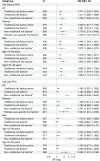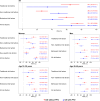Burden of Modifiable Risk Factors in Young-Onset Cryptogenic Ischemic Stroke by High-Risk Patent Foramen Ovale
- PMID: 40242852
- PMCID: PMC12101884
- DOI: 10.1161/STROKEAHA.124.049855
Burden of Modifiable Risk Factors in Young-Onset Cryptogenic Ischemic Stroke by High-Risk Patent Foramen Ovale
Abstract
Background: The incidence of young-onset ischemic stroke is rising, driven by cryptogenic ischemic stroke (CIS) and patients without vascular risk factors. This study examines the burden and associations of modifiable traditional, nontraditional, and female sex-specific risk factors with young-onset CIS, stratified by clinically relevant patent foramen ovale (PFO), defined by high-risk features of atrial septal aneurysm or large right-to-left shunt.
Methods: We enrolled consecutive patients aged 18 to 49 years with recent CIS and frequency-matched stroke-free controls of the same age and sex from 19 European sites. Logistic regression assessed the association of risk factor counts (12 traditional, 10 nontraditional, 5 female sex-specific) and individual risk factors, stratified by PFO. Analyses were stratified by sex and age (18-39 and 40-49 years), with computation of population-attributable risk.
Results: We included 523 patients (median age, 41 years; 47.3% women; 196 [37.5%] with PFO) and 523 controls. In patients with CIS without PFO, each additional traditional (odds ratio, 1.417 [95% CI, 1.282-1.568]), nontraditional (odds ratio, 1.702 [95% CI, 1.338-2.164]), and female sex-specific risk factor (odds ratio, 1.700 [95% CI, 1.107.1-2.611]) increased CIS risk. For patients with CIS with PFO, each traditional risk factor increased the risk (odds ratio, 1.185 [1.057-1.328]), but only nontraditional risk factors remained significant when fully adjusted (odds ratio, 2.656 [2.036-3.464]). Population-attributable risks for CIS without PFO were 64.7%, 26.5%, and 18.9% for traditional, nontraditional, and female sex-specific risk factors. For CIS with PFO, population-attributable risks were 33.8%, 49.4%, and 21.8%, respectively. Migraine with aura was the most significant contributor, with population-attributable risks of 45.8% for CIS with PFO and 22.7% for CIS without PFO, showing a stronger impact in women.
Conclusions: Despite the initial cryptogenic label of these strokes, traditional risk factors significantly contribute to CIS without PFO, while nontraditional factors seem more critical for CIS with PFO. Migraine with aura plays a prominent role in young-onset CIS development, particularly in women.
Registration: URL: https://www.clinicaltrials.gov; Unique identifier: NCT01934725.
Keywords: foramen ovale, patent; heart septal defects; ischemic stroke; migraine with aura; risk factors.
Conflict of interest statement
None.
Figures




References
-
- Rohr J, Kittner S, Feeser B, Hebel JR, Whyte MG, Weinstein A, Kanarak N, Buchholz D, Earley C, Johnson C, et al. . Traditional risk factors and ischemic stroke in young adults: the Baltimore-Washington Cooperative Young Stroke Study. Arch Neurol. 1996;53:603–607. doi: 10.1001/archneur.1996.00550070041010 - PubMed
-
- Haapaniemi H, Hillbom M, Juvela S. Lifestyle-associated risk factors for acute brain infarction among persons of working age. Stroke. 1997;28:26–30. doi: 10.1161/01.str.28.1.26 - PubMed
Publication types
MeSH terms
Associated data
LinkOut - more resources
Full Text Sources
Medical
Miscellaneous

